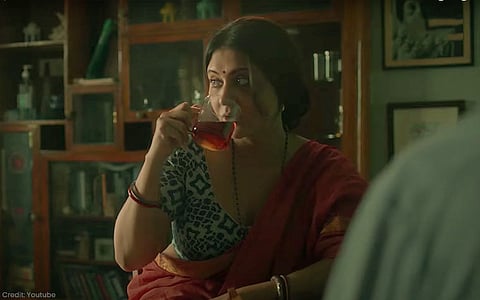
- Reviews
- Power List 2024
- Cannes 2024
- In-Depth Stories
- Web Stories
- News
- FC Lists
- Interviews
- Features
- FC SpecialsFC Specials

Director: Sudipto Roy
Cast: Swastika Mukherjee, Judhajit Sarkar
Streaming on: Hoichoi
The first thing you notice about Tasher Ghawr is its length. At 47 minutes, it is neither a feature nor a short. It plays out like an extended monologue presenting itself as a fourth-wall breaking piece to camera, taking the extreme, blinkered point of view of the protagonist, Sujata (Swastika Mukherjee), an unhappily married Bengali woman stuck in her apartment with an abusive husband (Judhajit Sarkar) in lockdown. TV news blares out information about the death toll in the Covid 19 pandemic as the husband sits in his drawing room sofa, shouting out orders to be served breakfast. The mood is that of a Sunday, with him being around, notes Sujata, except everyday is a Sunday during lockdown, and everyday is a terror.
The odd thing about Sujata is the chirpy tone she maintains as she tells us her story, focussing on seemingly minute details such as the smell of fish blood and merely slipping in the bit about last night's abuse as a side note. Even though the visuals—the black marks on her face, her dishevelled, neglected look, and the depressing, oppressive lighting and colour tone of the household—tell another story.
Divulging anything beyond this set-up would be akin to giving out spoilers about a film that unravels like a psychological, domestic thriller. Sudipto Roy's film—based on a story by Sahana Dutta taking off from the title of a Tarashankar Bandopadhyay story—draws on a premise that's very much a living reality for many—women stuck during lockdown with a monster spouse—and takes it to its dramatic conclusion. Sujata had found a way to co-exist with her unfaithful, ungrateful husband simply by being alone, watching films on TV and making friends with the rats in the house. In a pre-pandemic world he would leave for office, but come back only late at night, after he's done with meeting with his lover: which would give Sujata the chance to be free at her home. But what now?
Roy's film is set during the course of one day but it gives the impression of an eternity. But once you are past the first twenty minutes, it becomes apparent that the film's objective is to not portray Sujata as an object of pity but as someone who is in control, at the centre of her own narrative—so much so that we don't even see the husband's face; he is just a voice, and a pair of dangling feet in the drawing room.
Sometimes we cut to a flashback, or recall an incident that happened months ago, slowly getting to know our protagonist. Mukherjee has the right kind of ambiguity for Sujata and its a physical performance as much as it is an internal one, making use of make-up—or the lack of it—and costume and her body language to convey her state of being. But despite its merits I wonder why the film feels a bit cold and alienating. Being put into Sujata's head from start to finish allows us to be immersed in her reality, but by denying us any interaction that she has with any other human—she is a loner, and probably has mental health issues, too, so we don't see her use even a phone, not even texting—does it in fact push us further away from her?